Does anybody else remember the show Mythbusters? This was one of my favourite shows in the mid-00’s, when I was a tween-going-on-young-adult. Mostly because it involved blowing stuff up “for science”.
What really stuck with me, and the reason I’m mentioning it now, is the novel format of the show. The hosts would construct Rube Goldberg contraptions that they would detonate with high-end pyrotechnics. This was done to test the veracity of various urban myths and legends.
The final, empirical findings of their experiments would confirm one of three things. First, the myth could be “busted” and so the rigour of the scientific method had proven it false. Second, the myth could be “confirmed” – or established as being as close to fact as an old wives’ tale can be.

Last, and my personal favourite, was the verdict of “plausible”: they couldn’t state with certainty that the myth was true, but neither could they state that it was busted. I loved how the grey area preserved the rumour’s mystique.
And so, in honour of the show that defined a comfortable moment in my life, I’d like to bring their format to something that’s really at the top of the minds of a lot of us Canadian Miles & Points enthusiasts: American Express US cards.
Right now, we are seeing record high offers down south such as 100,000 US Membership Rewards points on the American Express US Platinum Card. If that’s not your cup of tea, you could try 125,000 Bonvoy points plus Platinum Elite status on the Marriott Bonvoy Brilliant instead.
Enticing, no? Well, to paraphrase Spiderman: “with great rewards comes great rumours of ability.” People have a lot of questions about how Canadians can get these cards and bonuses, and there’s all kinds of wild or misleading information floating around.
So let’s pull a Mythbusters. I’m going to list the weirdest assumptions about Amex US floating around our community. Then I’m going to establish, based on my personal experiences and data points from fellow enthusiasts, whether a myth is “busted” (false), “confirmed” (true), or “plausible” (your mileage may vary).
Before going down this rabbit hole, Ricky’s guide to getting US credit cards as a Canuck is pretty much mandatory. Without it, you’ll feel lost. Just read it, OK?!
Also, remember the following phone numbers as you read this article. If it’s your first Amex US card, this is the line you need to call first if anything goes pear-shaped.
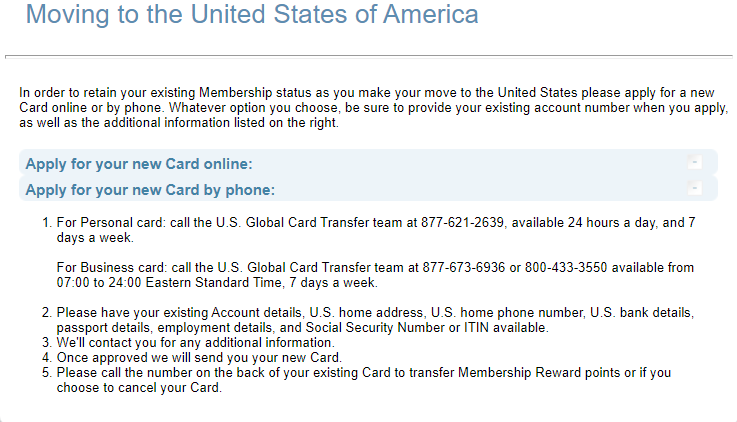
Myth #0: You Will Always Call Into Global Transfer
This is the mother of all Amex US myths, but I consider it to be settled: you’re gonna have to call in.
I’ve heard exactly two data points of people being approved instantly off of Nova Credit or an online Global Transfer. It doesn’t mean it’s impossible, it’s just rare.
When you apply for Amex US cards, be ready to call the number above. There is a 99% chance you’ll have to complete your application via phone.
Verdict: Confirmed (for 99% of applicants).
Myth #1: You Can Attach an ITIN After Applying for an Amex US Card

Time for a little review: an Individual Taxpayer Identification Number (ITIN), as Ricky detailed, is something that a Canadian can get if they have taxable income in the States. It replaces a Social Security Number (SSN) for the purposes of getting credit cards.
The reason that this is relevant is because, just like in Canada, in order to build credit history, one needs to demonstrate responsible credit usage. This is monitored through three credit bureaus (Experian, TransUnion, and Equifax), who maintain a file attached to your ITIN or SSN.
So what’s the holdup? Well, many Canadians follow the guide above and get an Amex US card via Nova Credit or Global Transfer. This involves, in some capacity, ticking the following box:
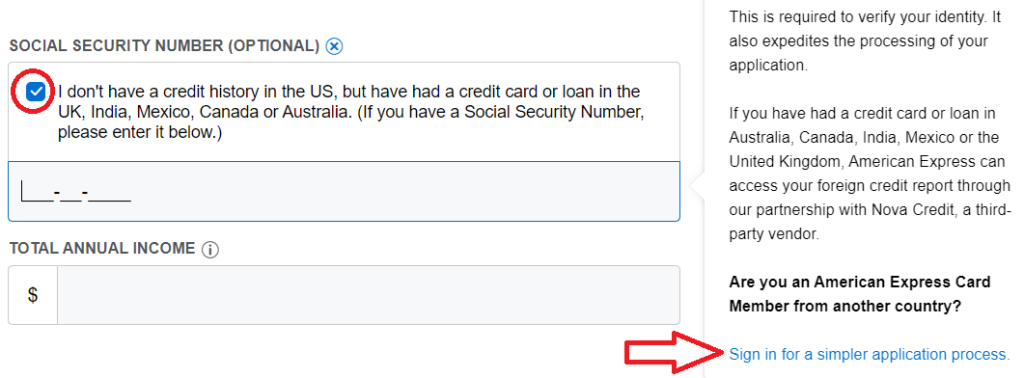
See that? It means you have no ITIN or SSN. So you might get the card, but it won’t be attached to anything. I want to stress the following:
You cannot, I repeat, cannot, under any circumstances whatsoever, period, between now and Skynet launching Judgement Day on all of us, retroactively attach an ITIN to an Amex US card that you’ve already been approved for, end of story.
This means your first Amex US card, if granted without an ITIN, builds credit history with American Express but not the bureaus. You cannot add an ITIN to this card. Won’t happen.
What you can do after getting your ITIN is apply for a second US Amex card. Simply attach your ITIN in the SSN box on this application.

In fact, this is the simplest way to allow you to construct a US credit history, as after this second application, your new (second) card will be attached to your ITIN, as will the credit history from your old (first) card. These will now be used to calculate your available credit, utilization, etc.
Verdict: Busted.
Myth #2: You Can Have Your New Amex US Card Shipped Directly to Canada
For obvious reasons, this is one of the most abounding questions for new Canadians getting into the US credit card game. There’s many people who think you can call Amex US Customer Service at +1 (800)-528-4800 and ask them to nicely forward your new card to you up North.

Bad news: you cannot, ever, no matter how many times you hang up, ever get Amex USA to budge on doing this for your first card. This is because they want to ensure your US address is legitimate. Going full Karen won’t save you, either.
Good news: once you’ve had your first card delivered to your address, gotten it in your hands, and kept your account in good standing a little while, you’re gold. Subsequent requests to have cards forwarded to your igloo in the Yukon will be granted via two-day FedEx.
Verdict: Confirmed.
Myth #3: You Don’t Need a US Bank Statement To Confirm US Address

OK, let’s be real here: Amex US has gone through lots of crackdowns on people gaming them for welcome bonuses. People engaged in egregious points manufacturing were even charged in federal court.
Basically, American Express US doesn’t muck about. So take what I’m about to say with a grain of salt, as it’s pretty clear they will want to verify your US address.
The way in which they will do this is by verifying the address on your application lines up with the address listed on a document that proves your address, such as a utility bill.
The best thing for you to provide is a bank statement with your US address listed. This should be from the same US bank account you opened after reading Ricky’s advice on getting into the US credit card game.
According to some mixed data points, there have been cases of people being approved without having to provide a bank statement or proof of address. These are scattered and inconsistent. Prepare for the worst, hope for the best.
Always apply for US American Express cards with some kind of proof of US address, just to be safe. If you don’t, you have to deal with the annoyance of the procedures detailed in the next myth….
Verdict: Plausible (but not recommended).
Myth #4: If You “Fail” A Three-Way Call, You Can’t Get a Reconsideration
This is the tandem twin of the previous myth.
One of the most common ways that you will have to verify your address is via a three-party call. American Express US will call you and your bank, and your bank will verify the address they have on file.
If you’ve updated your address at your US bank, and a bank rep picks up and confirms your address to Amex, you should be good to go. However, many hobbyists have reported their bank not responding to the call, or providing incorrect information to Amex.
This unfortunately results in the call being deemed a failure and the applicant being obligated to provide proof of US residency within 30 days.
Usually uploading a bank statement is good enough, but some applicants were told confusing information by customer service representatives, such as that they couldn’t get a reconsideration call, or that a bank statement wouldn’t be considered proof of address.
Don’t panic. Do the following:
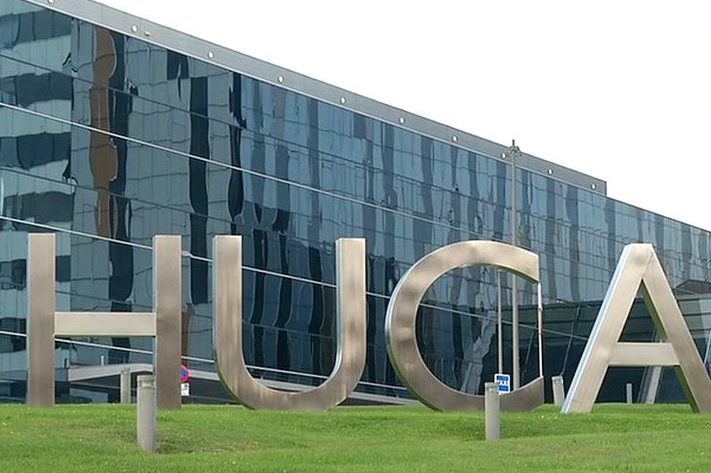
Push for a second reconsideration call: I’ve talked to a few people who even got a second three-party call the same day and opened their new card successfully.
If that doesn’t work, wait to be given 30 days to upload proof of address. Then just upload your bank statement, or maybe find a way to bill something to that address.
If you’re told that a bank statement doesn’t qualify, hang up and call again and someone speaking sense will pick up eventually. They’ll let you do either a three-party call or use a bank statement. And if they don’t, find a way to get a utility bill.
The road to US credit card-dom does not end here unless you let it.
Verdict: Busted.
Myth #5: You Must Have an ITIN to Hold Multiple American Express US Cards
Before I answer this question, I want to ask you a hypothetical: Do you have a favourite restaurant or store? Somewhere you’re a regular, and have a good relationship with the staff and owner, as well as buy a lot of stuff there?
Can you remember the last time such a place refused to sell you one of their products?
I’m betting the answer is no.
Amex US is the same way when it comes to applications. They like new customers, and due to interchange fees, they like when you use their products. You do not need an ITIN to get approved for multiple US Amex cards.
In fact, there are even confirmable data points of people getting approved for multiple American Express US cards through Nova Credit in a very short period of time, no ITIN needed, such as the following from the Prince of Travel Elites Facebook group:
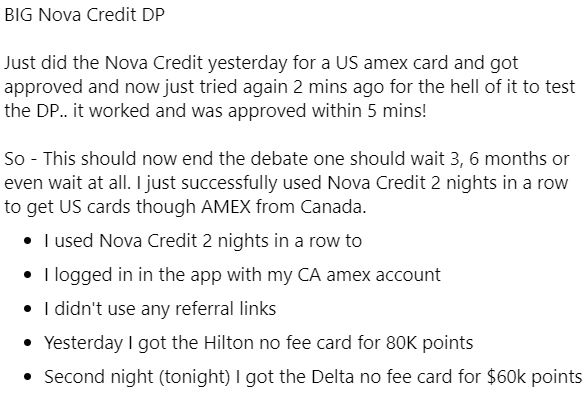
You will, however, need an ITIN if you ever want to play the rest of the US credit card field.
Verdict: Busted.
Myth #6: Amex Has a 2/90 Rule For Multiple Applications
Whilst in Canada, there have been data points of enthusiasts getting lucky and being approved for multiple cards (both credit cards and charge cards) in a short time, in America it’s a bit different.
Down south, you have to follow what’s known as the “2/90 Rule”. You can see from Ricky’s counterpart (and possible doppelganger) Sebastian from Ask Sebby that this means you can only get approved for two credit cards within 90 days.
You can get approved for more products within that timeframe: so long as only two are credit cards, the others must be charge cards. Business cards do count against this limit.
By the way, even if you’re under the 2/90 Rule and are eligible to be approved for a credit card, it doesn’t mean you’ll be immune to the “Pop-up of Death” (which, by the way, would be a great name for a garage band):
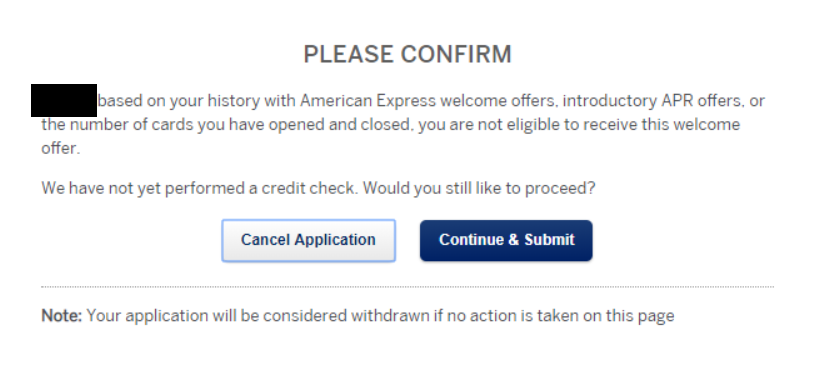
(I find the best way to get rid of this is to put a US$200+ spend on all my cards in the same statement period.)
Verdict: Confirmed (for credit cards).
Myth #7: Amex US Offers A Virtual Card Upon Approval For Instant Use
Much like Myth #2, I have good news here for you. Amex US does grant virtual credit cards.
Exactly like myth #2, this is only available after you’ve built a bit of a history with Amex. I didn’t get my instant-use virtual card until I had been approved for my third Amex US card, the Bonvoy Brilliant.
Anyone saying that you can do this on your first card is mistaken, or has existing US card history and so their situation is not the same as yours.
If you’re eligible for this, then when you apply, a popup box will give you the option to select an instant e-card. Then you’ll receive a virtual card number and a four-digit security code with a countdown timer. It’ll look like this:
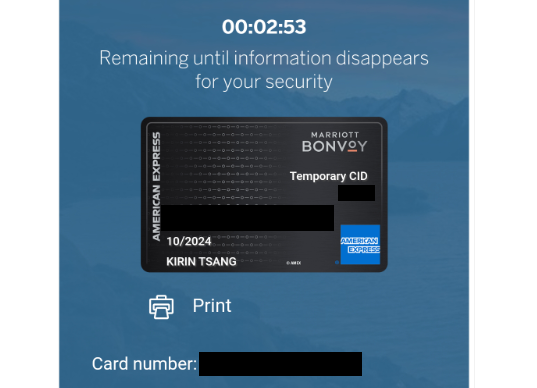
Copy the info and you’re off to the races! Heck, it even works with PayPal and mobile wallets.
Verdict: Confirmed.
Myth #8: You Can Use Referrals Without an ITIN
Good news! Unlike half the things on this list, you don’t need an ITIN for this, nor do you even need a history with US Amex.
Using your friends’ referral links to apply as part of an Amex Global Transfer is completely possible. I think the reason there’s some doubt about this is that, if you sign in to your Amex Canada account during the application process for an Amex referral offer, you can bust the system.
If you tick the “I don’t have an SSN” box and then choose to “sign in for a simpler application process”…

…you might get the following error message.

Fortunately, you can avoid this issue with referral links by going through the Nova Credit service, which will pull your Canadian credit file directly instead of using your history with Amex Canada (assuming you’ve signed up with Nova and approved them to do so).
Simply apply normally and tick off the “I don’t have an SSN” box, but do not log-in. Once you hit Submit, you’ll be redirected to Nova Credit, who will generate a credit report for Amex US to say yay or nay to.

If it’s your first Amex US card, refer to Myth #0, you’re going to call in. If not, and you have a history with Amex US, I’ve been told data points that this simply goes through successfully.
An added bonus of this is that you can use this to access the infamous Amex US incognito offers by browsing to the American Express website in incognito mode, finding the “secret offer” you’re interested in, and applying via Nova Credit. Really handy for your first card!
Verdict: Confirmed.
Myth #9: Amex US Scrutinizes Business Applications More Heavily
No. They don’t. You can apply for the 100,000 Bonvoy points on the Bonvoy Business with little hassle.
As usual, just don’t commit fraud or make claims you can’t backup. American Express isn’t dumb, they know your Amazon e-books that are thinly-veiled Outlander ripoffs aren’t netting you $40,000 per quarter.
Verdict: Busted.
Myth #10: Mail Forwarders Get Flagged by Amex
The genesis of this myth is that American Express, sooner or later, gets wise to the fact that many customers are using mail forwarders.
Of course, many such forwarders, such as 24/7 Parcel, wish to serve their customers and help them break into the American credit card market as part of their Miles & Points dream.
![]()
Sadly, there’s been data points that some enthusiasts’ US addresses have been rejected from the application process entirely for being mail forwarders. Others have had their credit cards tossed in the trash by unscrupulous forwarders.
Still others have been approved, but had to go through further address verification steps (similar to those in Myths #3 and #4), or even had Amex refuse to ship credit cards to their chosen residence.
Of particular concern is that the location for 24/7 Parcel may have been flagged for some customers’ accounts, with those customers no longer able to receive new credit cards until they had “moved” their bank statements/proof of address to the new address provided. On the upside, 24/7 actively tried to improve the situation for all affected.
It does seem like the trend may be towards more flagging, but we have no official confirmation on this, as the majority of forwarders are still functioning well.
My recommendation: find friends in the US to include in your Miles & Points hobby and form mutually beneficial relationships with them. Failing that, if you’ve been flagged, hedge your bets by digging deeper for a more tacit mail forwarder than the openly-advertised 24/7 Parcel.
Verdict: Plausible (and not in a good way).
Conclusion
It’s evident that American Express US signup bonuses are at an all-time high whilst Canadian bonuses suffer. There’s been no better time in the memory of anyone in the community to try and get into the US credit card game.
At the same time, be wary of myths and urban legends that surround this. The effects of “broken telephone” only get amplified over the internet and, of course, many of us aren’t in situations where we can regularly meet up with other enthusiasts to compare tips and tricks.
That being said, I hope that you enjoyed journeying down the river of my memory. As time goes on and data points trickle in, I’ll be sure to update this list so that the community can remain aware of the “do’s-and-don’t-poke-the-bears” of American Express US.
If you enjoyed this style, I’d really like to continue paying homage to this classic show by continuing to find myths in the Miles & Points community, research them, and bust (or confirm!) them.
Until next time, may your options ever be plausible.

















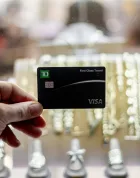

Are the myths and the verdicts for Canadians only? Otherwise I would like to state some objections based on data points for German / middle European people who went through Global Transfer (Nova not applicable/possible for them).
Hi Kirin,
Thanks for the great article. Myth #1 is a little confusing to me. To confirm, you CANNOT attach an ITIN to already approved AMEX US cards. However, if you apply for a new AMEX US card after getting an ITIN, they will report to Equifax your ITIN number for this new card and therefore it would end up allowing you to see all your AMEX US credit cards on Equifax?
Last point, how are you guys getting credit reports in the US? Equifax, myFICO and annualcreditreport won’t let me sign up with my ITIN.
Thank you.
You can add me for a data point for Myth #0!
Initially tried to apply for Bonvoy Brilliant (incorrectly), rejected, but then applied for Amex Hilton Honors a week later (via Nova) and got instantly approved! Family member is arriving this week with primary and secondary cardholder cards!
A great article Kirin, well done. Admire your style.
Hope more will follow. Continued success!
I have a feeling you have a pretty good grasp of all things related to ITIN. That would fly high and be of interest to all
Thanks Kirin. I am very struggle applying for my second Amex card after the GT. They requested the transcript of tax return for the 2 applications I made for the Amex Gold. One was 3 months after I got my first card and the second one was 3 months after that. I don’t get the NOVA option after the first card either.
I would like to ask what is the best way to apply for new US Amex after the GT.
1. Shall I click I don’t have credit history in the US or just enter a fake SSN like 99999999?
2. Shall I enter any income in the application? Previous I used my income in Canada not sure if why they keeping asking me the tax return.
3. How can I apply via NOVA again? or is that only the one time thing.
Thanks in advanced
Same thing happened to me, they’re just confused you used Novacredit.
Now, did you call in? You need to call into the GT team and ask for them specifically, they can get you to the proper paperwork
Don’t commit fraud or use somebody else’s SSN.
Nova the DP in the article notes you can do it more than once, I have one friend who used them three times.
Honestly, calling in is your best option.
Thanks for your advise. I finally got my second personal card approved as well as a business bonvoy approved at the same day.
This is one way to get a US credit card, but there are easier methods.
An easier way is to sign up with RBC USA and you can apply for one from RBC when you open your bank account with them. You’ll likely need the bank account anyway to pay US bills and this is the best option since you can transfer funds instantly between the two sides.
Important note- if you aren’t a RBC Canada customer, before opening an account with RBC USA, open two basic savings accounts with RBC Canada (a CAD one and a USD one). You need these in order to easily fund the RBC US account. They cost nothing and you never get charged for making transfers to the RBC US accounts. You do not need a chequing account with RBC to make this work. I think you even get one free withdrawal a month with these savings accounts assuming you get the right one.
Anyone can get US RBC and TD credit cards. The whole point about getting US Amex cards is because they have some of the highest value amongst US credit cards. Unlike RBC and TD’s credit cards, Amex cards are worth the trouble.
Counterpoint to myth #2: it took a bit of HUCA, but I was able to get my first US AMEX card shipped directly to Canada. They can verify your identity with NotaryCam.
This is a lot of effort for most people. If more data points trickle in I’d happily change it to Plausible, though, as you’re the first. Congrats on your first US Amex!
I can confirm this DP as I was also able to have my first card shipped to Canada before receiving it. It should be noted that it is the card replacement team that does it though. So it is a different number than the first one they already sent out to you. They use notary cam to confirm identity and send out the replacement
Is it practical to get the first card ship to Canada this way?
1. Have the card mailed to your US address
2. Ask friend/border pickup company to destroy the card (even use it once to activate)
3. Call Amex to let them know that you have returned to Canada due to business/family emergency, and you just lost your wallet/card.
4. Asked Amex to mail you a replacement card to Canada.
Incentivizing your readers to pump those lucrative referral offers 😉
To add to “Myth #7: Amex US Offers A Virtual Card Upon Approval For Instant Use”, I received a virtual US Amex Platinum on Nov 15 and the 4-digit CID was temporary and had an expiration date of Dec 1 (15 days). I’m now waiting for my physical card to arrive after being forwarded to my Canadian address.
re: Myth #2
I’ve applied for a few different AMX cards and had to wait a few weeks to receive them here in Canada. There is a way to speed this up. Once you’ve been approved for the card, call back 24hours later and ask for a replacement card be sent to your canadian address. Use covid as an excuse and that you cant get home to your US address right now to pick up the original. They will gladly send you a replacement card to your Canadian address. usually within a few days. Trash the original when it finally arrives.
This was confirmed to me by the AMX rep.
My newly approved first Amex card was delivered to my US address. Called Amex customer rep and advised that I could not cross the border to get my card due to Covid-19 restrictions. I was provided with directions on how to validate my Canadian driver’s license or Canadian passport. It was through notarycam.com/amex. Uploaded a scanned copy of my passport, met a rep from notarycam via webcam and showed my actual passport. It was like less than 2 minutes. The following day I called Amex Card Replacement Dept. and my card has now been sent to my Canadian address.
Excellent data point! Very helpful, I’ll update it when we get some more confirmations. I suspect we will see a lot of signups.
Another Myth confirmed. It’s possible to click a referral link and get the higher incognito offer instead.
Great stuff Kirin! Love the format. I can add a DP: I failed my 3 way call because my credit history can get complicated and I got a question wrong. The option provided to me was to upload a letter from the bank, on letter head, confirming my address and that my account was in good standing. They wouldn’t accept a bank statement. After a few phone calls I was able to get it done.
“This means your first Amex US card, if granted without an ITIN, builds credit history with American Express but not the bureaus.”
So does this mean the credit balance on this card doesn’t show up anywhere except at Amex? What about your Canadian credit history?
They stop caring about your Canadian history the moment you get your first card. Thereafter, no ITIN=good only with Amex USA.